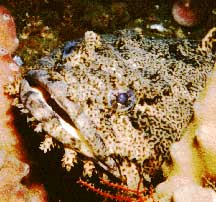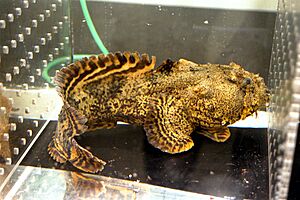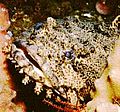Oyster toadfish facts for kids
Quick facts for kids Oyster toadfish |
|
|---|---|
 |
|
| Conservation status | |
| Scientific classification | |
| Synonyms | |
|
The oyster toadfish, also known as Opsanus tau, is a unique fish found in the Northwest Atlantic Ocean. People sometimes call it the ugly toad, oyster cracker, oyster catcher, or bar dog. It belongs to the Batrachoididae family, which are often called toadfish.
This fish can grow up to about 43 centimeters (17 inches) long. However, most oyster toadfish are a bit smaller, usually around 38 centimeters (15 inches). The biggest one ever recorded was almost 49 centimeters (19 inches) long! They usually have a yellowish body with brown stripes that go across it.
Contents
Where They Live and What They Eat
Oyster toadfish are very tough creatures. They can live in places where the water quality isn't great. They also don't need a lot of food to survive.
These fish are omnivores, which means they eat both plants and animals. Their diet often includes crabs, snails, squid, and other smaller fish. Oyster toadfish are experts at camouflage. They stay very still, blending in with their surroundings. When a tasty meal swims close by, they quickly attack! You can find these fish near the shore, from the state of Maine all the way down to Florida.
Special Sounds and Reproduction
Male oyster toadfish make a special "foghorn" sound. They use this sound to attract females during mating season. This season runs from April to October. The muscles that make this sound are attached to their swim bladders. These are the fastest known muscles in any animal with a backbone!
After hearing the foghorn sound, a female will come to the male's nest. She lays her eggs there and then leaves. Oyster toadfish lay the largest eggs of any fish found in the Chesapeake Bay. The male then fertilizes the eggs. They hatch after about one month.
When the young toadfish hatch, they stay attached to their yolk for a while. The yolk gives them energy to grow. Once the yolk is gone, the young fish learn how to swim. Even after they can swim on their own, the adult male toadfish continues to protect them.
Venomous Spine
Be careful if you ever see an oyster toadfish! They have a venomous spine on their first dorsal fin. If you get stung by it, the pain is often compared to a bee or wasp sting.
Oyster Toadfish in Space
In 1998, NASA sent some oyster toadfish into space! Scientists wanted to see how being in microgravity (weightlessness) would affect their inner ear organs. These organs help with balance. The study found that the toadfish developed almost the same way in space as they did on Earth.
Images for kids




